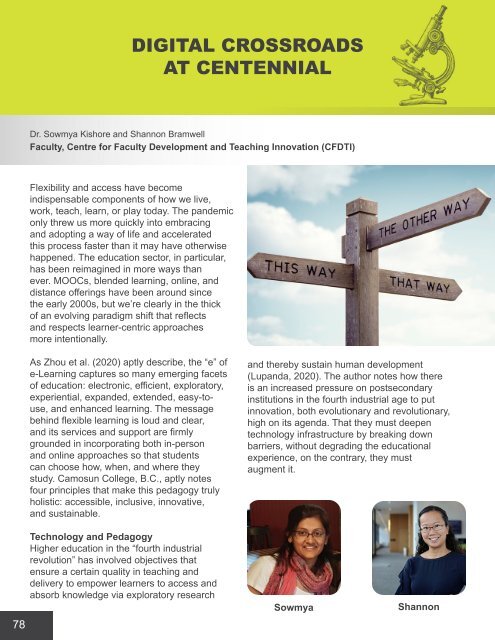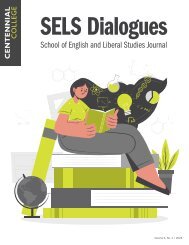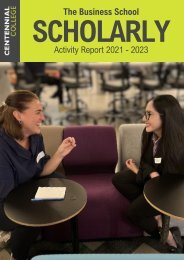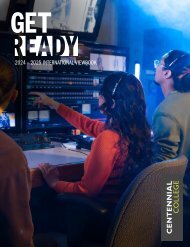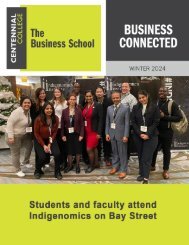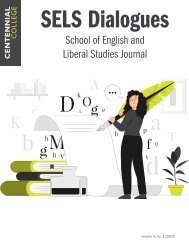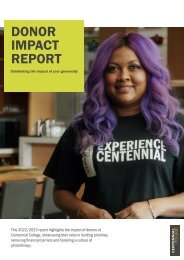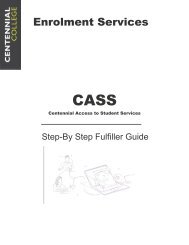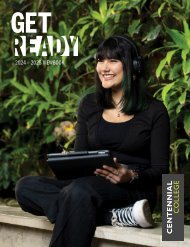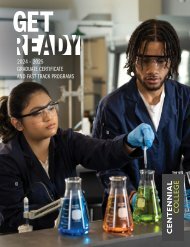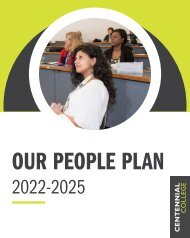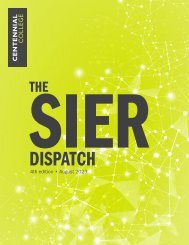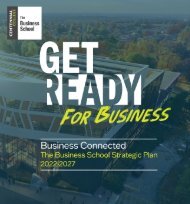The Teaching and Learning Innovation Digest - May 2023
Welcome to a truly special edition of the Teaching and Learning Innovation Digest! Our seventh annual academic publication has assumed an incredibly meaningful shape and form for a number of reasons. Not only did we receive an enthusiastic response with over 30 submissions via our institutional broadcast, but we also have consciously and intentionally embraced the principles of Universal Design for Learning by attempting to represent and celebrate the varied forms of expressions therein. From reflective essays, poetry, visual and performing arts, podcasts, video conversations to scholarly work, academic and applied research, news and updates, and interviews, this is truly a power-packed publication!
Welcome to a truly special edition of the Teaching and Learning Innovation Digest! Our seventh annual academic publication has assumed an incredibly meaningful shape and form for a number of reasons. Not only did we receive an enthusiastic response with over 30 submissions via our institutional broadcast, but we also have consciously and intentionally embraced the principles of Universal Design for Learning by attempting to represent and celebrate the varied forms of expressions therein. From reflective essays, poetry, visual and performing arts, podcasts, video conversations to scholarly work, academic and applied research, news and updates, and interviews, this is truly a power-packed publication!
You also want an ePaper? Increase the reach of your titles
YUMPU automatically turns print PDFs into web optimized ePapers that Google loves.
78<br />
DIGITAL CROSSROADS<br />
AT CENTENNIAL<br />
Dr. Sowmya Kishore <strong>and</strong> Shannon Bramwell<br />
Faculty, Centre for Faculty Development <strong>and</strong> <strong>Teaching</strong> <strong>Innovation</strong> (CFDTI)<br />
Flexibility <strong>and</strong> access have become<br />
indispensable components of how we live,<br />
work, teach, learn, or play today. <strong>The</strong> p<strong>and</strong>emic<br />
only threw us more quickly into embracing<br />
<strong>and</strong> adopting a way of life <strong>and</strong> accelerated<br />
this process faster than it may have otherwise<br />
happened. <strong>The</strong> education sector, in particular,<br />
has been reimagined in more ways than<br />
ever. MOOCs, blended learning, online, <strong>and</strong><br />
distance offerings have been around since<br />
the early 2000s, but we’re clearly in the thick<br />
of an evolving paradigm shift that reflects<br />
<strong>and</strong> respects learner-centric approaches<br />
more intentionally.<br />
As Zhou et al. (2020) aptly describe, the “e” of<br />
e-<strong>Learning</strong> captures so many emerging facets<br />
of education: electronic, efficient, exploratory,<br />
experiential, exp<strong>and</strong>ed, extended, easy-touse,<br />
<strong>and</strong> enhanced learning. <strong>The</strong> message<br />
behind flexible learning is loud <strong>and</strong> clear,<br />
<strong>and</strong> its services <strong>and</strong> support are firmly<br />
grounded in incorporating both in-person<br />
<strong>and</strong> online approaches so that students<br />
can choose how, when, <strong>and</strong> where they<br />
study. Camosun College, B.C., aptly notes<br />
four principles that make this pedagogy truly<br />
holistic: accessible, inclusive, innovative,<br />
<strong>and</strong> sustainable.<br />
Technology <strong>and</strong> Pedagogy<br />
Higher education in the “fourth industrial<br />
revolution” has involved objectives that<br />
ensure a certain quality in teaching <strong>and</strong><br />
delivery to empower learners to access <strong>and</strong><br />
absorb knowledge via exploratory research<br />
<strong>and</strong> thereby sustain human development<br />
(Lup<strong>and</strong>a, 2020). <strong>The</strong> author notes how there<br />
is an increased pressure on postsecondary<br />
institutions in the fourth industrial age to put<br />
innovation, both evolutionary <strong>and</strong> revolutionary,<br />
high on its agenda. That they must deepen<br />
technology infrastructure by breaking down<br />
barriers, without degrading the educational<br />
experience, on the contrary, they must<br />
augment it.<br />
Sowmya<br />
Shannon<br />
To this end, at Centennial, our approach has<br />
allowed an array of projects <strong>and</strong> opportunities<br />
in the recent past, from the HyFlex Pilot to<br />
BringIT (bring your own device) initiative <strong>and</strong><br />
the transformation of st<strong>and</strong>ard classrooms into<br />
active learning spaces. Although all College<br />
initiatives share commonality in striving<br />
towards “empowering technology to empower<br />
people”, each project is uniquely suited to<br />
different learners <strong>and</strong> teachers:<br />
HyFlex: HyFlex provides the greatest amount<br />
of flexibility <strong>and</strong> autonomy to the learner<br />
whereby they get to choose how they wish to<br />
interact with each lesson on a weekly basis:<br />
i.e. live in-person, online synchronously,<br />
or online asynchronously at a later<br />
time. HyFlex classrooms have been equipped<br />
with state of the art audio/visual equipment<br />
in an effort to create a seamless video<br />
conferencing experience for those in person<br />
as well as those tuning in remotely. A pilot<br />
that was launched in Fall 2021 has resulted in<br />
more courses <strong>and</strong> programs embracing this<br />
approach across schools <strong>and</strong> campuses in the<br />
last two years.<br />
BringIT: As the college strives to model the<br />
future of work for both its employees, as well<br />
as students who are training for the workforce,<br />
the BringIT initiative allows for the affordances<br />
of technology to be brought into the classroom,<br />
as students each bring a device of their<br />
own. This project has adopted a technologyequity<br />
approach within programs; several<br />
being fully immersed in technology, while most<br />
others taking a ‘technology-enhanced’ path,<br />
thus allowing each area to make necessary<br />
upgrades be it curriculum, pedagogical, or<br />
industry related. It also ensures all programs<br />
integrate digital literacy <strong>and</strong> digital fluency in<br />
a scaffolded approach that maintains human<br />
connectedness, learning, <strong>and</strong> the needs of our<br />
learners in focus.<br />
Active <strong>Learning</strong> Classrooms: With increased<br />
technology in our lessons, many classrooms<br />
have also received a classroom transformation<br />
with updated <strong>and</strong> added hardware to support<br />
classes. <strong>The</strong>se spaces across Progress<br />
<strong>and</strong> Morningside Campuses have been<br />
transformed with multiple screens <strong>and</strong> access<br />
points, allowing for the display of various<br />
content simultaneously. <strong>The</strong> furniture in these<br />
rooms are fully movable, encouraging a more<br />
equitable classroom setting where there is no<br />
front or back of the room <strong>and</strong> learning is coconstructed<br />
between faculty <strong>and</strong> learners.<br />
<strong>The</strong>se agile <strong>and</strong> flexible initiatives present a<br />
very different view of teaching. No longer is the<br />
teacher the sole contributor when planning <strong>and</strong><br />
preparing a lesson. Rather, the preparation<br />
of lessons involves a host of parties<br />
with various expertise, coming together<br />
in the shared teaching <strong>and</strong> learning<br />
space. <strong>The</strong> inclusion of learning technologists<br />
to help choose technology tools, the use of<br />
instructional designers to help lay out course<br />
content, as well as the assistance of audio/<br />
visual <strong>and</strong> IT support staff to ensure lessons<br />
are delivered smoothly.<br />
This interdisciplinary approach requires<br />
underst<strong>and</strong>ing <strong>and</strong> respect for each individual’s<br />
role <strong>and</strong> a collaborative way to design engaged<br />
learning opportunities.<br />
79


